Conservation and Project News
:
The Amakosa Rocksitter
spp (Durbania amakosa albescens)
This sub-species of the Amakosa Rocksitter was
discovered near the town of Margate on the Kwa-Zulu Natal south coast.
And was described by Mr Graham Henning of the
Lepidopterists Society of Africa. This butterfly differs from the nominate
race of Durbania Amakosa, in that it has a more pronounced, whitish irroration
on the apex of the upperside of the forewing, as well as on the undeside
of the hindwing. Also the cilia of both the male and female display broader
area's of white, The upperside discal spots of the male are more yellowish.
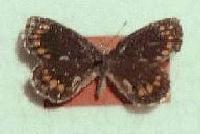
|
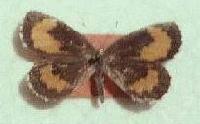
|
|
Durbania
amakosa albescens - Male
|
Durbania
amakosa albescens - Female
|
This butterfly is on the wing from December to January, and only three
small colonies of this sub-species have ever been found. This is an intriguing
small butterfly, which can be very easliy overlooked unless it is being
specifically searched for. The rocksitter is very reluctant to fly even
when approached, and will remain immobile for long periods. When they settle
on a rock they have they habit of walking backwards towards the ground.
The underside of the butterfly resembles the background, thus giving it
perfect camouflage.
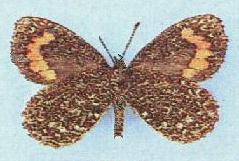 |
|
Durbania
amakosa albescens - Female underside
|
The female butterfly lays her eggs on lichen covered rocks. The lichen
is also the host on which the caterpillars feed on. The caterpillars also
pupate in cracks and crevices on the side of the rocks, usually a little
way above the level of the soil. They are more often than not concealed
behind grass, growing around the rocks. The whole life-cycle of the Amakosa
Rocksitter occurs on the lichen covered rocks, the butterfly only flying
off when it is searching for a mate. It is sad to note that the survival
of this sub-species is under threat, due to housing development projects.
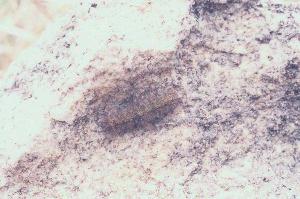
|

|
|
Durbania
amakosa albescens - Larvae
|
Durbania
amakosa albescens - Pupae
|
Another one of the colonies in the Margate area is also being threatened
by low cost housing, however the situation is being monitored closely.
A
A
New
Butterfly House
A
We are currently constructing a new free flying house for the butterflies,
on the Impenjati Butterfly Farm. This will be the fourth house on the farm,
and will also be one of the largest. The new house will have a breadth
of 50 mt, it will be 65 mt in length, and 12 mt tall.
A
Butterfly
Fauna of the Mpenjati Nature Reserve
A
A survey of butterflies of the Mpenjati Nature Reserve, took place
from the 1st of October, 2003 to the 30th of September,
2004. The objective here, was to obtain initial data on the composition
of the butterfly fauna, ansd to elaborate the first ever
checklist for the reserve. (Click on the button for the full report,
which is in PDF format).
AA
A
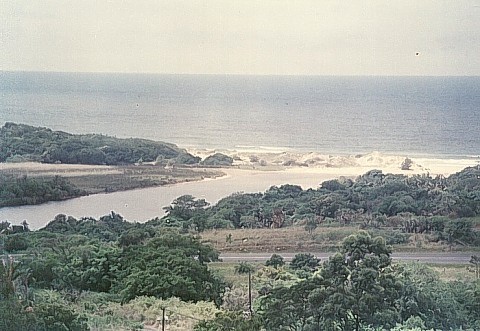 |
|
Photograph
of the Mpenjati Nature Reserve - Palm Beach - KwaZulu Natal
|
A
A
 A
A
A
Host
Plants
A
A "Host Plant", is a plant on which the female butterflies lay their
eggs, and on which the larvae feed on until they pupate.
Larvae are very particular eaters, and have very specific food requirements.
Some will use a variety of trees for a host plant,
while others will only utilize one variety of a plant. Whichever is
the case, there is no substitute for a caterpillars food
requirements. You canít just throw in some grass or spinach and expect
the larva you just found to survive. Also, a larva that
eats milkweed cannot switch to eating lemon leaves. Some butterflies
will lay groups or masses of eggs on one leaf (Acraea),
while others will only lay one egg per plant to ensure enough food
for her caterpillar. Normally, they will only lay on the host
plant. Once a larva starts to feed, it becomes programmed to that host
plant species. The Impenjati Butterfly Farm is currently
assisting members of the local population with the planting of butterfly
host plants in the Umtamvuna, San Lameer and Impenjati Conservancies, as
well as plants which are high in nectar for the adult butterflies.
A
A
Assessing
The Annual Change in Butterfly Populations
(San
Lameer Estate - KZN - South Africa)
A
The project makes use of butterfly data gathered during regular transects
in areas. The transect method involves the
establishment of a fixed route across a site. This route is divided
into a number of sections, which usually vary in length and
habitat type. Every week walks are carried out along the transect,
with the number of individuals of each butterfly species
counted in each section. The walks are carried out at a slow steady
pace. Counts are only made during the day. In the analysis
of the data, weekly counts for each species are summed to calculate
annual indicies of abundance, which are measures of
population size. This exercise will provide information on the ecology,
including population trends, the effects of habitation
management, changing distribution patterns (Spread / decline), phenology,
population dynamics, migration and the effects of the weather.
A
A
Butterfly
Garden
A
Butterflies need nectar from flowers to satisfy their energy needs.
Therefore, the more varieties of flowers there are, the greater
are the chances of attracting different species of butterflies. Butterflies
also need the sun to warm their body temperature, they
will therefore position themselves during the night so that the early
morning sun touches their wings to warm them. If you want
to attract butterflies to your garden it helps to be tolerant because
butterflies prefer a natural look rather than a "tidy" garden.
That means allowing weeds to grow in the landscape. It also means that
pesticides need to be avoided. To attract more species
of butterflies, you could add to the butterfly garden a mud puddle,
and perhaps a bowl of rotting fruit. With or without these
additional lures, however, many butterflies will be enticed to visit
a garden that provides desirable nectar sources which are not
poisoned with insecticides. It is advisable to plant the butterfly
garden in a location that is sheltered from the wind. Wind makes
flight maneuver difficult for butterflies and require the expenditure
of extra energy as they try to feed, mate, and lay eggs. A
wind break can be provided by simply planting trees on the perimeter
to protect the garden from prevailing winds. To enable
the sight of most of the flowers (and butterflies) in your garden,
plant the shortest flowers in front and the tallest ones in the
back. Plant flower species in masses as butterflies seem to choose
those flowers that are most abundant. Being equipped with a
highly sensitive sense of smell, butterflies are able to identify clusters
of nectar flowers from quite a distance. We are in the
process of establishing a large butterfly garden on the Impenjati Butterfly
Farm.
A
A
Invasive
Alien Invader Plants
A
With the introduction of ; "Invasive Alien Invader Plants", which have
either been introduced deliberately or accidently, have
now become the prefered host plants for several species of butterflies.
These alien invaders are capable of invading stable
natural vegetation. They are on the increase and have caused irreversable
changes to natural plant cover in some area's. These
plants are also aggressive growers, the seeds can also lie dormant
for up to 50 years. Survival of a butterfly species depends on
the success of the habitat meeting the species unique requirements.
These requirements include an adequate food supply for the
larvae, as well as; "Nectar" plants, for the adult butterflies to feed
on. Indiscriminate removal of these aliens from an area could
also lead to the extinction of that particular butterfly colony, due
to the fact that no thought is given to replace these plants with a
suitable alternative. Studies are currently being conducted by using
butterflies as a means of controlling these alien plants,
natutally.
AAAA
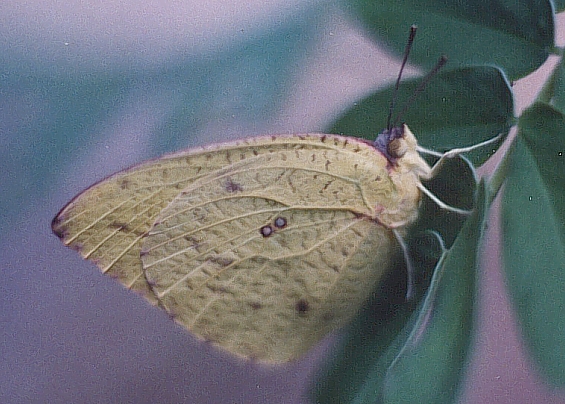
|
| Catopsilia
florella - Female on host plant "Peanut
Butter Cassia", (Senna didymobotrya). |
Aa
An example of this is the; "African Migrant", (Catopsilia florella),
which now has a preference for the "Peanut Butter Cassia",
(Senna didymobotrya). Which the butterfly uses as a food plant for
it's larvae to feed on.
A
 |
|
Catopsilia
florella - Male
|
AAAA
This butterfly can be found on the wing throughout
the year. The eggs are laid singly on its host plant. The eggs are long
and tapered, and can be easily seen on the leaves of the host plant. This
species of butterfly can be found throughout southern africa, and it is
also a very common insectA
AAAAa
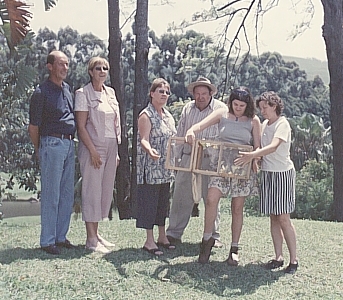
|
Release
of Catopsilia florella butterflies on the San Lameer Estate by
members
of the Impenjati Butterfly Farm and San Lameer Conservancy |
A
aaa
aaaButterfly
Migration
aaaaaaaa
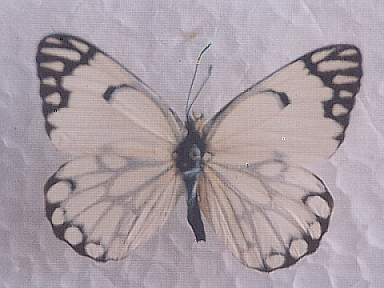 |
|
The
Brown-veined white (Belenois aurota) - Male
|
This is one of the most common of the "White"
butterflies in Southern Africa, and can also be found throughout the rest
of Africa where there is suitable habitat. It is a member of the "Pieridae"
family. Each year large migrations of this butterfly takes place in Southern
Africa in a north-easterly direction. As the butterfly migrates the female
deposits her eggs on a suitable host plants on the way, of which there
are sevreral. A study of the migration of this butterfly is currently in
progress.
aaaaaaaa
A
Go Back











